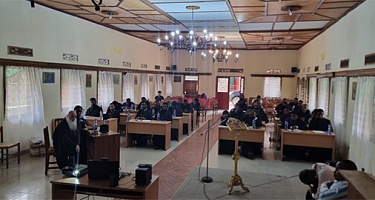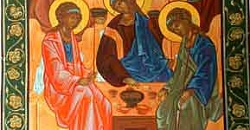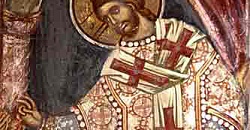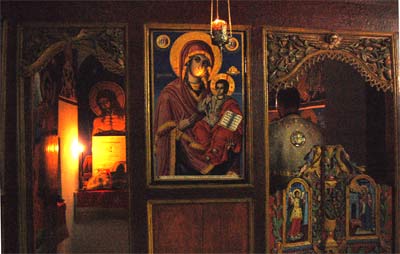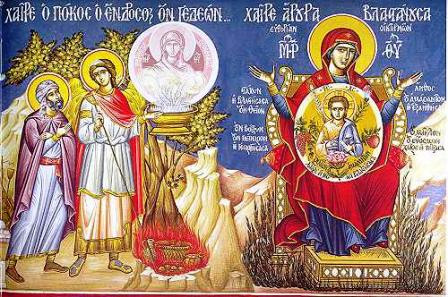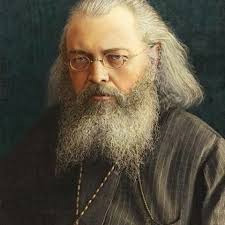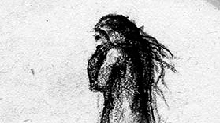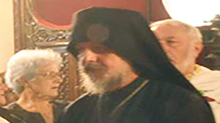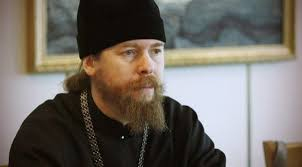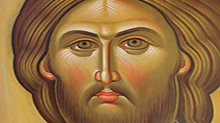Добродетелите во Лествицата на свети Јован Лествичник и Египетскиот Патерикон – Игумен Гаврил
Вовед
Бидите совршени како што е совршен вашиот Отец на небесата (Мт 5,48)

Тоа е основното начело и смисла зошто Бог го створил човекот. Во рајот човекот живееше во согласност со неговата природа, во појавата на гревот се разруши таа природна состојба, и се раскина заедницата на човекот со Бога, а дијалотог беше прекинат. Како последица на гревот настана и расцеп во самата природа на човекот. Тој се откина од изворот на природните благодатни енергии, од коишто се хранеше, умот му се помрачи а во неговото срце се зацарија страстите. Мерзоста на запустението седна на своето место. Тврдината на нашето срце е освоена, затоа е потребно повторно да се поврати власта над тврдината, односно да се очисти срцето од страстите. На тој пат на очистување подвижникот поминува три нивоа на духовен растеж: чистење на срцето, просветлување на умот и обожување. Лествицата и Египетскиот Патерикон преставуваат неисцрпни и постојано актуелни енциклопедии и кодекси на вистинско христијанско живеење во Светиот Дух. Во Лествицата се опфатени триесет поуки, описани во вид на скала по која монахот треба да се искачи за да достигне духовно совршенство. Совршенство е Самиот Богочовек Христос како единствен критериум за сите вредности, Којшто се наоѓа на крајот од скалата. Патот до тоа совршенство е борба со страстите. Со победата над одредена страст, душата ја стекнува соодветната добродетел и се зацврстува во доброто. Лествичник го опишува подвигот систематски и во сите негови детали. Ја анализира страста од сите можни и неможни аспекти на нејзината вгнезденост во душата. Како искусен лекар и психолог, го одредува степенот на болеста, и потоа го препишува лекот и начинот на лечењето. Речиси сите поуки и совети на Свети Лествичник кореспондираат со умот на подвижникот. Кога човекот ќе ги прочита овие упатства, добива една светлина во умот, едно знаење на нештата, коешто тој подоцна го користи во борбата за очистување на своето срце од страстите. Бидејќи го поминал патот и ја достигнал целта, сега како искусен стратег и воин, и како оној кој се извежбал во безстрастието, застанува и својата емпирија ја преточува во теорија, го осветлува патот што секој борец треба да го помине од својот почеток до крајот. Со тоа свети Лествичник на душата и прибавува едно теоретско познание и еден умствен увид за она што подвижникот практично го живее и вкусува. Духот на Египетскиот Патерикон е поинаков. Тој зборува низ тишината на пустината како извор на жива вода, неизглаголиви зборови и невидлива светлина. За драмата на благодатниот жив живот, за праксата на подвижникот, самите Старци и свети Отци преобразени и свети личности, не пишувале, туку сведочеле со својот свет и плиротичен живот –„Старче, доволно ми е само да те гледам“1, и со збор, ако имало потреба од тоа. Аввите не се морални личности, тие се луди Христа ради, ослободени од секаков јуридичко-еретички систем. Нивниот етос е маченичкиот, ’дај крв, прими Дух‘2. И тука основна тема е очистувањето на срцето од страстите и стекнување на блаженото безстрастие или совршенството преку стекнувањето на добродетелите. Како што погоре спомнавме, во однос на добродетелите во Лествицата преовладува теоретско објансување, додека во Старечникот добродетелта најчесто е опишана низ пример од секојдневниот живот на Отците од пустината. И покрај тоа што Лествицата го храни срцето, таа воглавно е храна за умот, а Отечникот најчесто го храни срцето. И кога овие две компоненти ќе се соединат во една, теоријата со праксата, умот со срцето, се доаѓа до првобитната човекова состојба на интергралност и прибраност пред Бога. Состојба на непрестајно повикување на Името Божјо внатре во очистеното срце, насладување со Неговите Боженствени благодатни енергии и гледање на Неговото Лице.
Преку овој труд ќе се обидеме да го синтетизирам предходно кажаното, земајќи ги во предвид добродетелите од Лествицата и поткрепувајки ги со соодветен пример од Отечникот. Ќе ја извлечеме суштината на добродетелта, ќе ги откриеме искушенијата што ја следат, ќе ја дијагностицираме внатрешната состојба на срцето и начинот на борба со страстите за стекнување на соодветната доблест, како лек и терапија, која пак си го повлекува со себе своето ’семејство‘ на сродни доблести, создавајќи во душата на подвижникот ’нови‘ состојби.
*Текстот е извадок од дипломската работа на о. Гаврил на Теолошкиот Факултет свети Климент Охридски во Скопје, 2000 г.
Извор: http://www.stprohor.org.au/
The virtues in the ladder of St. John of the Ladder and the Egyptian Paterikon – Abbot Gabriel
Introduction
Be perfect, as your heavenly Father is perfect (Mt, 5;48)
This is the basic principle and purpose why God has created man. In heaven man was living in accordance with his nature, but with the accepting of sin this natural state was disrupted and the communion of man and God was broken; the dialogue was interrupted. The sin resulted in split personality of man. Man cut himself off the source of the natural graceful energies that were feeding him; his mind became darkened and the throne of his heart was taken over by passions. The abomination that causes desolation sat on a holy place. Thus the fortress of our heart is conquered; that is why it is necessary to regain rule over it, i.e. to cleanse the heart from the passions. On their way of cleansing the ascetics pass three stages of spiritual growth: cleansing of the heart, illumination of the nous and theosis (deification). The Ladder of Divine Ascent and the Egyptian Patericon (The Sayings of the Desert Fathers) are inexhaustible and all-time relevant encyclopedias and codexes of true Christian living in the Holy Spirit.The Ladder is comprised of thirty lessons, arranged in the style of a ladder along which the monk is supposed to ascent in order to acieve spiritual perfection. Perfection is to be found in Christ the Godman, the only criterion of all values, Who is at the top of the ladder. The road to perfection leads through fighting with the passions. By overcoming a certain passion, the soul achieves a corresponding virtue and becomes more stable in doing good. St John the Climacus describes the struggle in a systemaic and detailed manner. He analyzes the passions from all possible aspects of their nesting into the soul. Just like an experienced physician or psycologist, he determines the stage of the disease and then prescribes the medicine and the way of treatment. Almost all of the lessons by St John of the Ladder correspond to the mind of the ascetic. Once we have read these instructions, our mind is enlightened – we receive knowledge that our mind is able to use in the struggle of cleansing our hearts from the passions. Since he himself passed the road and achieved the goal of conquering passions, now – as an experienced strategist and warrior, as one who has exercised in impassionateness – he stands and turns his experience into theory, lights the way that each warrior is supposed to pass from beginning to the end. Thus St John of the Ladder gives the soul a theoretical knowledge and a real insight into what an ascetic practically lives and tastes.
The spirit of the Egyptian Patericon is different. It speaks through the silence of the desert like a spring of living water, words unspeakable and light unseen. These Elders and Holy Fathers – transfigured and holy persons – did not make any written notes about the drama of their life full of grace, about their ascetical practice, but they testified with their own sanctified and plerotic life – “Abba, it is enough for me only to watch you”. Sometimes, in case word was needed, they also offered testimonies with a word. The Abbas are not merely moral persons, they are fools for Christ, freed from all kinds of judicial or ethical system. They follow the martyr ethos: “give blood, take Spirit”.
Here the main topic will be the cleansing of the heart from the passions and acquiring the blissful state of impassion i.e. the state of perfection, which ia only possible through the acquiring of virtues. As we mentioned before, in The Ladder the virtues are explained theoretically, while in the Patericon virtues are usually described through the everyday life of the Fathers in the desert. The Ladder feeds the heart but it is predominantly food for the mind, while the Patericon mainly feeds the heart. So, when these two components are united into one – theory with practice; the mind with the heart – then we go back to the primeval human state of integrity and self-composure in front of God. This is the state of continuous evoking of the name of God within the cleansed heart, feasting with His divine graceful energies and watching of His face.
In this article we will synthetize what we have said before; we will take into consideration the virtues from The Ladder and support them with a corresponding example from the Patericon. We will extract the essence of a certain virtue, find out about the tempations that arise from it, then we will diagnose the inner state of the heart and the way of fighting the passions in order to gain the corresponding virtue. This virtue would also serve as a cure and therapy and it would entail its “family” of kin virtues, thus creating “new” states into the soul of the ascetic.
* The text is an excerpt from the graduation work of Fr. Gabriel at the TheologicalFaculty of St. Kliment Ohridski in Skopje in 2000









